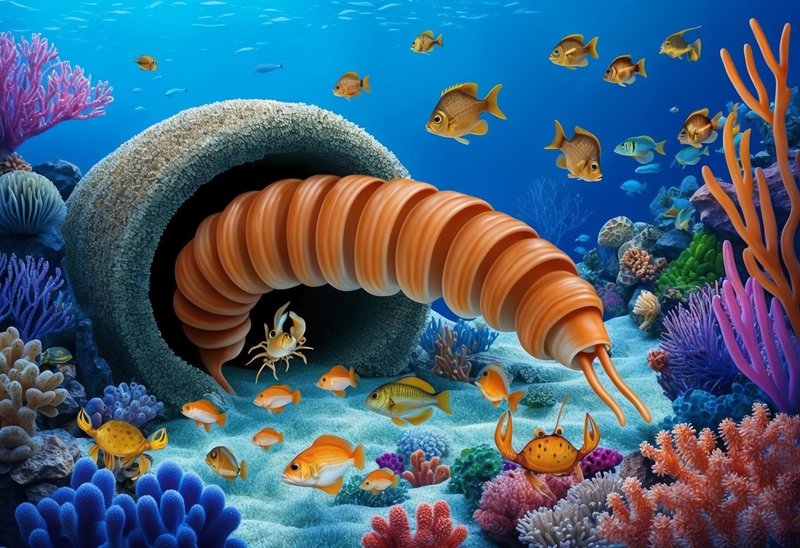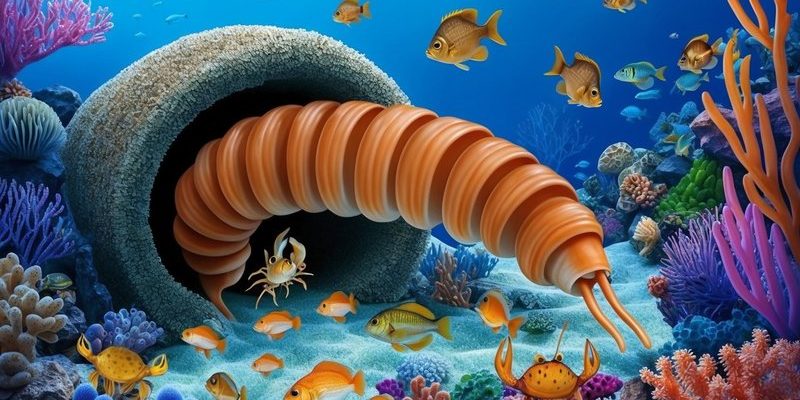
While many animals have their preferred meals, bobbit worms are a bit more selective, choosing between fish and crustaceans based on factors like availability and environmental conditions. In this article, we’ll dive into the world of bobbit worms, exploring their hunting techniques, prey preferences, and the reasons behind their choices. So, grab a cup of coffee, and let’s unravel the mysteries of these underwater predators together!
What Are Bobbit Worms?
Before we get into their prey selection, it helps to know a bit about bobbit worms themselves. Also known as *Eunice aphroditois*, these worms can grow impressively long, often reaching lengths of over three feet. They have long, segmented bodies adorned with colorful bristles that can be mesmerizing to look at. Found in tropical waters, they usually burrow into the ocean floor, hiding from sight until they’re ready to strike.
In addition to their impressive size, bobbit worms have a unique hunting strategy that sets them apart from many other predators. They construct a burrow and lie in wait, using their keen senses to detect movement in the water above. When an unsuspecting fish or crustacean swims by, the worm can react almost instantaneously, lashing out with its powerful jaws.
How Bobbit Worms Hunt
So, how do these worms actually hunt? Their strategy combines patience and precision. They spend a lot of time camouflaged at the bottom, waiting for the right moment to strike. When they sense nearby movement—thanks to their sensitive antennae—they spring into action.
Bobbit worms utilize a rapid, jerking motion to seize their prey. They can quickly extend their bodies out of their burrows, snatching fish or crustaceans with their sharp jaws. Think of it like an underwater ambush; they’re masters at hiding and then pouncing.
This hunting method is incredibly effective, allowing them to catch a variety of prey. But what exactly do they prefer—fish or crustaceans? Let’s dig deeper into their dietary choices.
Prey Preferences: Fish vs. Crustaceans
When it comes to selecting their next meal, bobbit worms show a clear preference based on several factors. Both fish and crustaceans are on the menu, but the type of prey often depends on availability, size, and the worm’s hunger level.
For instance, if larger fish are more prevalent in an area, bobbit worms may target those as a primary food source. Alternatively, when crustaceans like shrimp or crabs are abundant, that might be the worm’s go-to choice. This flexibility in diet ensures that the bobbit worm can thrive in different environments.
Interestingly, the composition of their surrounding ecosystem influences their prey preference as well. In reefs bustling with crustaceans, a bobbit worm may find it easier to catch a smaller crab or shrimp than a faster-moving fish, thus favoring crustaceans in that scenario.
The Nutritional Value of Fish and Crustaceans
Another factor affecting prey selection is nutritional value. Fish and crustaceans provide different benefits, and bobbit worms seem to instinctively know what they need at any given time.
Fish are typically rich in protein and fats, which can provide a significant energy boost. On the other hand, crustaceans are packed with essential minerals and vitamins. Depending on the bobbit worm’s health needs, it may lean towards one type of prey over the other.
In a nutshell, it’s like fueling up your car: sometimes you need regular gasoline (fish), other times you prefer premium (crustaceans). The worm’s ability to choose its meal based on nutritional needs is a testament to its adaptability in a constantly changing environment.
The Role of Environmental Conditions
Environmental conditions play a crucial role in prey selection for bobbit worms. Factors such as water temperature, salinity, and habitat structure can influence which prey items are most accessible.
For example, in warmer water conditions, fish might be more active, leading to a higher likelihood of bobbit worms catching them. Conversely, if the environment favors crustacean growth (like certain types of algae or vegetation), the worms will likely switch their focus to catch those easy meals.
Moreover, during spawning seasons, when fish become more abundant, bobbit worms may have a feast at their disposal. It’s fascinating how these worms can adapt their hunting strategies based on the ebb and flow of their surroundings.
Competition and Threats
Bobbit worms aren’t alone in their pursuit of meals; they face competition from other predators in their habitat. Fish and crustaceans also have their own defenses, which can affect the bobbit worm’s success rate in hunting.
For instance, some fish species are quick and can avoid capture, while certain crustaceans can use hard shells for protection. As a result, the bobbit worm must continuously adapt its hunting techniques, sometimes even waiting longer for the right opportunity to strike.
Additionally, environmental threats, like changes in water quality or habitat destruction, can impact prey availability. These factors can make life tougher for bobbit worms, affecting their diet and overall health.
Understanding the prey selection of bobbit worms reveals not just their hunting prowess, but also their adaptability in the marine ecosystem. Whether they prefer fish or crustaceans, their choices are influenced by numerous factors, from nutritional needs to environmental conditions.
So next time you find yourself near a reef or sandy ocean floor, take a moment to consider the bobbit worm—this remarkable predator that knows how to navigate challenges and make the best choices for survival. The ocean is full of wonders, and bobbit worms are just one of many creatures showcasing the art of prey selection.

